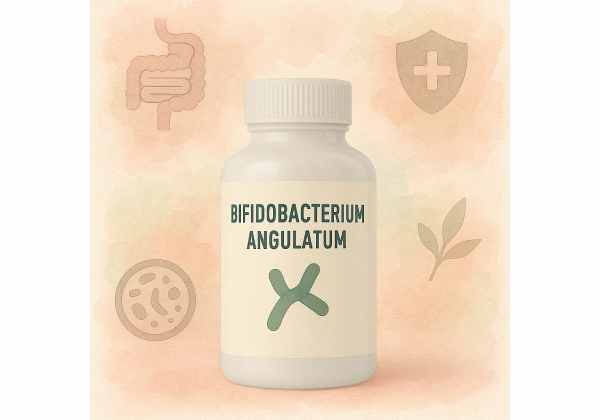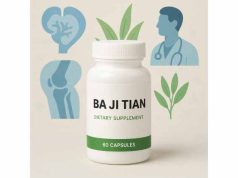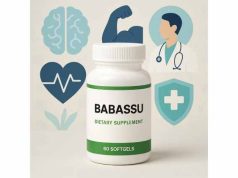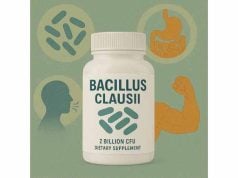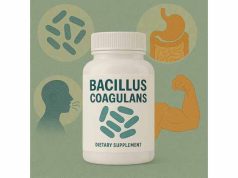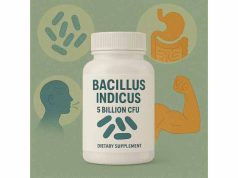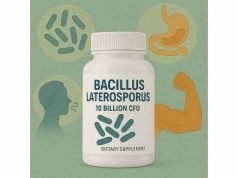Bifidobacterium angulatum is a promising probiotic species naturally present in the human gut, yet often overlooked compared to more common strains. As research on the human microbiome expands, B. angulatum has been recognized for its ability to support digestive regularity, strengthen the gut barrier, and contribute to immune and metabolic balance. With unique metabolic properties, it helps break down complex carbohydrates, promotes the production of vital short-chain fatty acids, and supports the growth of other beneficial bacteria. Understanding its role, optimal dosing, and safety profile can empower you to make more informed choices about your gut health. Let’s explore the science, applications, and best practices for Bifidobacterium angulatum supplementation.
Key Takeaways
- Bifidobacterium angulatum helps maintain gut balance, supports digestion, and strengthens the gut barrier.
- It contributes to the production of important short-chain fatty acids, influencing metabolism and immune regulation.
- Emerging evidence suggests potential benefits for relieving constipation, supporting healthy cholesterol, and assisting recovery after antibiotics.
- Generally safe for healthy adults, but those with immune disorders or critical illness should consult a healthcare provider before use.
- Choose reputable probiotic products with transparent labeling and appropriate CFU counts for best results.
Table of Contents
- Bifidobacterium angulatum Introduction and Core Functions in the Human Gut
- Understanding the Science: How Bifidobacterium angulatum Impacts Gut and Whole-Body Health
- Health Benefits and Evidence-Based Uses of Bifidobacterium angulatum
- Safety Profile, Possible Side Effects, and Interactions of Bifidobacterium angulatum
- Dosage Guidelines, Optimal Usage, and Administration for Bifidobacterium angulatum
- Frequently Asked Questions About Bifidobacterium angulatum
Bifidobacterium angulatum Introduction and Core Functions in the Human Gut
Bifidobacterium angulatum is a species of probiotic bacteria belonging to the Bifidobacterium genus, a group widely recognized for their beneficial effects on human health. While not as heavily researched as Bifidobacterium longum or Bifidobacterium bifidum, B. angulatum is an essential, naturally occurring resident of the human large intestine, especially in adults.
What is Bifidobacterium angulatum?
- It is a Gram-positive, anaerobic (thrives in the absence of oxygen) microorganism.
- First isolated from human fecal samples, B. angulatum is recognized as a stable member of the adult gut microbiota, contributing to the maintenance of a healthy microbial community.
- It forms part of the “core” gut bacteria, present from early life through adulthood, though its abundance and influence can change with age, diet, and health status.
Unique Biological Role and Functions
B. angulatum is notable for its metabolic versatility. It excels at fermenting various dietary fibers, including complex carbohydrates that are otherwise indigestible by human enzymes. This process produces short-chain fatty acids (SCFAs) like acetate and butyrate, which:
- Serve as vital energy sources for colon cells.
- Help maintain the integrity of the gut barrier, reducing the risk of “leaky gut.”
- Possess anti-inflammatory properties that benefit gut and systemic immune balance.
How Bifidobacterium angulatum Differs from Other Probiotics
While all Bifidobacteria provide some common benefits, B. angulatum distinguishes itself through:
- A unique ability to utilize a broader spectrum of plant-based fibers, supporting a more diverse and resilient gut microbiome.
- Support for the colonization and function of other beneficial bacteria, such as other Bifidobacterium and Lactobacillus species.
- Production of specific metabolites that may influence cholesterol metabolism, blood sugar regulation, and the overall gut environment.
Why Is Bifidobacterium angulatum Important?
A healthy abundance of B. angulatum is considered a sign of gut ecosystem stability. Its presence is associated with:
- Lower levels of gut inflammation.
- Improved digestive comfort and regularity.
- Better resilience against harmful microbes and pathogens.
- Enhanced ability to recover gut balance after antibiotic use.
Natural Sources and Modern Supplementation
- B. angulatum naturally colonizes the intestines through early life exposures, including birth and breastfeeding.
- Its abundance can be diminished by poor diet, stress, illness, and especially antibiotic use.
- While small amounts may be found in certain fermented foods, targeted supplementation provides standardized, evidence-based support for boosting B. angulatum levels.
Who May Benefit from Bifidobacterium angulatum?
- Adults seeking to optimize digestive function and regularity.
- People recovering from antibiotic therapy who wish to restore gut microbiome diversity.
- Those interested in metabolic and cholesterol support through probiotic action.
- Anyone seeking science-backed probiotic support for whole-body health.
It’s important to remember that individual results depend on your existing microbiome, dietary habits, and overall health. Probiotics like B. angulatum work best as part of a balanced wellness routine that includes fiber-rich foods, physical activity, and good stress management.
Understanding the Science: How Bifidobacterium angulatum Impacts Gut and Whole-Body Health
To appreciate the benefits of Bifidobacterium angulatum, it’s important to understand how it works at the biological and molecular level. Research reveals that B. angulatum acts through several complementary pathways to support digestive, immune, and metabolic wellness.
1. Advanced Fiber Fermentation and SCFA Production
B. angulatum harbors unique enzymes that allow it to ferment a wide variety of prebiotics (special plant fibers that nourish beneficial gut bacteria) and resistant starches. Through this process, it produces SCFAs—primarily acetate and butyrate:
- Acetate: Supports the growth of other probiotics and helps maintain an acidic gut environment that deters pathogens.
- Butyrate: Feeds colon cells, supports repair of the gut lining, and reduces inflammation.
These metabolites help regulate intestinal pH, provide energy to colon cells, and exert wide-ranging benefits beyond the digestive tract.
2. Strengthening the Gut Barrier
The intestinal barrier is crucial for protecting the body from harmful substances while allowing nutrients to pass through. B. angulatum supports the production of mucus and proteins that “seal” the gut lining, reducing the risk of increased intestinal permeability, sometimes called “leaky gut.”
- This enhanced barrier function helps lower the risk of unwanted immune reactions and chronic inflammation linked to digestive and systemic conditions.
3. Inhibiting Harmful Microorganisms
Through competitive exclusion, B. angulatum helps prevent colonization by harmful bacteria and yeasts:
- It competes for space and nutrients, creating an environment where pathogens struggle to thrive.
- Produces antimicrobial substances (bacteriocins) that directly inhibit certain undesirable microbes.
4. Modulating the Immune System
B. angulatum interacts with immune cells lining the gut wall, influencing immune responses in several ways:
- Encourages the growth of regulatory T-cells, which help keep immune reactions in check.
- Lowers the production of pro-inflammatory cytokines (chemical messengers that drive inflammation).
- Supports tolerance to non-harmful substances, helping to reduce allergies and food sensitivities.
5. Supporting Metabolic and Cardiovascular Health
Emerging evidence links B. angulatum to improvements in metabolic markers, such as:
- Cholesterol Regulation: Certain SCFAs influence liver cholesterol metabolism and may help lower LDL (“bad”) cholesterol.
- Blood Sugar Balance: By improving gut barrier integrity and reducing inflammation, B. angulatum may contribute to healthier glucose regulation.
6. Recovery After Antibiotics or Illness
Because antibiotics and illness can diminish beneficial gut bacteria, supplementing with B. angulatum helps:
- Speed recovery of gut flora balance.
- Support digestive comfort and reduce the risk of antibiotic-associated diarrhea or yeast overgrowth.
Summary Table of B. angulatum Mechanisms
| Mechanism | Health Impact |
|---|---|
| Advanced fiber fermentation | SCFA production, gut barrier health, pH balance |
| Gut barrier enhancement | Reduced “leaky gut,” improved immune regulation |
| Inhibiting harmful microbes | Lower pathogen load, reduced infection risk |
| Immune modulation | Lower inflammation, better allergy tolerance |
| Metabolic and cardiovascular | Improved cholesterol, blood sugar balance |
B. angulatum’s impact goes far beyond digestion—it supports the interconnected health of the gut, immune system, and metabolism.
Health Benefits and Evidence-Based Uses of Bifidobacterium angulatum
As science advances, more is being discovered about the clinical applications and real-world value of Bifidobacterium angulatum. Here’s how this powerful probiotic may support your health, according to emerging research and best practices.
1. Improving Digestive Regularity and Comfort
- B. angulatum helps restore normal bowel movements and reduces occasional constipation by fermenting dietary fibers and producing SCFAs, which enhance intestinal motility.
- It also supports the breakdown of gas-producing fibers, leading to less bloating and discomfort for many users.
2. Supporting Gut Microbiome Diversity
- Supplementing with B. angulatum can help replenish and diversify the gut flora after antibiotic use or digestive disturbances.
- A richer microbiome is linked to improved digestive resilience, nutrient absorption, and immune function.
3. Enhancing Immune Defense
- B. angulatum’s influence on gut-associated lymphoid tissue (GALT) and regulatory T-cells may strengthen the body’s ability to fight infections and keep inflammatory reactions in check.
- Some early studies suggest possible reductions in allergy symptoms and improvements in immune response during cold and flu season.
4. Promoting Metabolic Wellness
- By supporting SCFA production and healthy gut barrier function, B. angulatum may play a role in regulating cholesterol and blood sugar.
- Some clinical data link higher B. angulatum levels with healthier lipid profiles and markers of glucose metabolism.
5. Recovery After Antibiotics
- Antibiotic therapy can dramatically reduce beneficial gut bacteria, leading to digestive upset and increased risk of infection.
- Supplementing with B. angulatum has been shown to help speed recovery, reduce antibiotic-associated diarrhea, and prevent the overgrowth of harmful microbes.
6. Emerging Research: Brain and Mood Health
- There is growing interest in how B. angulatum may affect the gut-brain axis. Early research suggests that its SCFAs and immune-modulating effects may support mental clarity and balanced mood.
- While more research is needed, some users report improved focus and resilience to stress when including B. angulatum as part of a probiotic regimen.
7. Additional Potential Benefits
- May support healthy weight management by influencing satiety hormones and reducing inflammation.
- Possible role in reducing risk factors for metabolic syndrome and cardiovascular disease.
Who Should Consider Bifidobacterium angulatum?
- Adults looking for natural solutions to digestive regularity and resilience.
- Those recovering from antibiotic use, illness, or digestive disruptions.
- Individuals aiming to maintain optimal metabolic, immune, and gut health.
- Anyone seeking a well-tolerated, science-supported probiotic as part of a daily wellness routine.
Summary Table of Key Benefits
| Health Goal | How B. angulatum May Help | Evidence Level |
|---|---|---|
| Digestive regularity | Increases SCFA, improves motility | Strong (human/lab data) |
| Microbiome restoration | Replenishes good bacteria after antibiotics | Strong (clinical/lab) |
| Immune support | Modulates immune response, lowers inflammation | Moderate (clinical/lab) |
| Metabolic wellness | Supports cholesterol, blood sugar regulation | Early (pilot/observational) |
| Post-antibiotic recovery | Reduces diarrhea, infection risk | Moderate (clinical/lab) |
| Cognitive & mood support | Early research on gut-brain benefits | Early (preclinical) |
Bifidobacterium angulatum’s evidence-based benefits make it a smart addition for those who prioritize proactive gut and whole-body health.
Safety Profile, Possible Side Effects, and Interactions of Bifidobacterium angulatum
Bifidobacterium angulatum, as a natural resident of the healthy adult gut, is considered extremely safe for the majority of users when consumed in supplement form. However, like any probiotic, its use comes with certain considerations—especially for sensitive populations or those with pre-existing health conditions. Understanding its safety profile, potential side effects, and interactions will help you make informed decisions and maximize its benefits.
1. General Safety Overview
Most healthy adults can use B. angulatum with confidence. This probiotic is not associated with pathogenicity (disease-causing ability) and has a long history of safe use in both food and supplement settings. Clinical and laboratory research confirms a very low risk of adverse effects when taken at recommended dosages.
2. Common and Rare Side Effects
While adverse effects are rare, some individuals may experience mild, short-term symptoms as their microbiome adjusts to increased probiotic intake:
- Mild digestive changes: Temporary gas, bloating, or mild stomach cramps may occur during the first few days. These typically resolve as your gut environment adapts.
- Slight changes in stool pattern: Some may notice softer stools or increased frequency. This is usually a sign of increased fiber fermentation and improved motility.
Serious side effects are extremely rare. However, if you experience persistent or severe discomfort, stop using the supplement and consult your healthcare provider.
3. Who Should Use Extra Caution
Although B. angulatum is safe for most, the following groups should consult a physician before starting any probiotic:
- Immunocompromised individuals: People undergoing chemotherapy, organ transplant recipients, or those with immune deficiencies have a higher risk for rare but serious infections, including bacteremia (bacteria in the blood).
- Hospitalized or critically ill patients: Only take probiotics under direct medical supervision in these cases.
- Infants and young children: While some probiotics are formulated for children, dosing and strain selection should be guided by a pediatrician.
- People with short bowel syndrome or severe gastrointestinal disease: Always check with a gastroenterologist or specialist first.
4. Allergic Reactions
Allergies to Bifidobacterium angulatum itself are extremely uncommon. However, adverse reactions may occur due to inactive ingredients, fillers, or allergens in some commercial supplement products. Signs of an allergic reaction include:
- Hives, rash, or itching
- Swelling of the face, lips, or throat
- Difficulty breathing
If these symptoms occur, seek medical help immediately.
5. Drug and Supplement Interactions
B. angulatum is not known to cause significant interactions with most medications or supplements. Still, keep these key points in mind:
- Antibiotics: Antibiotic medications can reduce probiotic populations. For best results, separate B. angulatum doses by at least 2–3 hours from antibiotics, or begin supplementation after finishing your antibiotic course.
- Immunosuppressive drugs: As with all probiotics, those taking immune-modulating or suppressing medications should use caution and seek medical advice.
- Other probiotics and prebiotics: Multi-strain probiotic use is common and generally safe, but very high doses may increase digestive side effects. Combining B. angulatum with prebiotic fibers can be beneficial for growth but may also temporarily increase gas for some users.
6. Quality and Purity Considerations
Safety and efficacy depend heavily on supplement quality. To reduce the risk of contamination and ensure you are getting the correct strain:
- Purchase from reputable brands with third-party quality testing.
- Look for supplements that specify the strain and colony-forming unit (CFU) count.
- Follow storage instructions (refrigeration if required) to maintain potency and safety.
7. When to Stop Use and Seek Help
Discontinue B. angulatum and contact your healthcare provider if you experience:
- Persistent or severe abdominal pain, vomiting, or high fever
- Blood in stool or signs of systemic infection
- Any symptoms suggestive of an allergic reaction
Summary of Safety Tips
- B. angulatum is well-tolerated and safe for most adults.
- Mild digestive changes are common and temporary.
- Immunocompromised and critically ill individuals should consult a healthcare provider before use.
- Quality, properly stored products reduce risk of contamination and ensure safety.
A thoughtful, evidence-based approach to B. angulatum supplementation helps you enjoy its many potential benefits with minimal risk.
Dosage Guidelines, Optimal Usage, and Administration for Bifidobacterium angulatum
Choosing the right dose, supplement form, and timing for Bifidobacterium angulatum is essential for effective and safe use. Here’s how to optimize your experience based on research, expert consensus, and best manufacturing practices.
1. Typical Dosage Recommendations
- Adults: Most B. angulatum supplements provide between 1 billion (1 × 10⁹) and 10 billion (1 × 10¹⁰) CFUs per serving. This range is effective for gut health, microbiome restoration, and immune support.
- Children: Specialized pediatric products may contain lower doses and require consultation with a healthcare provider.
- Multi-strain formulas: B. angulatum is often included in comprehensive probiotic blends for broader support, with similar CFU ranges per strain.
2. Supplement Forms
- Capsules/Tablets: Most common, easy to swallow, and convenient for daily use.
- Powdered Blends: Can be mixed into water, smoothies, or soft foods. This format is ideal for those with swallowing difficulties.
- Multi-strain Formulas: B. angulatum frequently appears alongside other Bifidobacterium or Lactobacillus species, often for synergistic digestive and immune benefits.
3. Timing and Administration
- With or without food: B. angulatum can be taken at any time, but taking it with a meal may improve survival through stomach acid and reduce mild digestive side effects.
- Consistency is key: Daily, regular use (same time each day) helps maintain optimal probiotic levels and increases effectiveness.
- After antibiotics: If recovering from antibiotic use, start your probiotic routine either immediately after completing your prescription or at least 2–3 hours apart from antibiotic doses.
4. Duration of Use
- Short-term use: For acute gut disruptions (like post-antibiotic recovery), a 2–4 week course is common.
- Long-term use: Many people benefit from continued daily use for ongoing digestive regularity, immune support, and microbiome diversity. Long-term supplementation is safe for most healthy adults.
5. How to Maximize Effectiveness
- Combine with a diet rich in prebiotic fibers (oats, bananas, onions, garlic, asparagus) to help B. angulatum thrive.
- Drink plenty of water to support healthy digestion.
- Avoid taking with very hot beverages, which may reduce probiotic viability.
6. Adjusting Dosage
- Increase: If you do not notice any digestive or wellness improvements after several weeks and experience no side effects, you may gradually increase within the recommended range.
- Decrease or pause: If gas or bloating persists beyond a week, lower your dose or take a brief break before restarting.
7. Storage and Stability
- Follow product instructions regarding refrigeration. Some strains are shelf-stable, but heat and moisture can reduce potency.
- Check expiration dates and avoid using supplements past their prime.
8. What to Look For in a Quality Product
- Clearly labeled strain (Bifidobacterium angulatum and, ideally, strain number)
- Guaranteed CFU count through expiration
- Independent third-party testing for quality and purity
Summary Table of Dosage and Administration
| User Type | Typical Dose | Timing | Duration |
|---|---|---|---|
| Healthy adult | 1–10 billion CFU/day | With/without food | Short or long-term |
| Post-antibiotics | 1–10 billion CFU/day | After course/2-3 hr separation | 2–4 weeks or longer |
| Children | Lower, pediatric formula | With food | As advised by doctor |
Responsible use of B. angulatum—at the right dose and from trusted sources—makes it an easy addition to your proactive health routine.
Frequently Asked Questions About Bifidobacterium angulatum
What is Bifidobacterium angulatum used for?
Bifidobacterium angulatum is used to support digestive regularity, restore gut microbiome balance after antibiotics, promote immune function, and may help with metabolic and cholesterol wellness.
Is Bifidobacterium angulatum safe for daily use?
Yes, B. angulatum is considered safe for daily use in healthy adults. If you are immunocompromised or have serious health concerns, check with your healthcare provider before starting any probiotic.
How does Bifidobacterium angulatum benefit digestion?
It ferments dietary fibers to produce short-chain fatty acids, which fuel colon cells, support regularity, and strengthen the gut barrier, reducing bloating and discomfort.
Can Bifidobacterium angulatum help after antibiotics?
Yes, clinical and laboratory evidence shows B. angulatum can speed up recovery of beneficial gut bacteria, reduce antibiotic-associated diarrhea, and restore microbiome balance.
Does Bifidobacterium angulatum interact with medications?
It is not known to cause significant drug interactions, but antibiotics can reduce its effectiveness. Separate probiotic doses from antibiotics by a few hours, and consult your doctor if on immunosuppressive therapy.
How long should I take Bifidobacterium angulatum?
For post-antibiotic recovery, 2–4 weeks is typical. For general digestive and immune support, daily long-term use is safe for most people.
What foods contain Bifidobacterium angulatum?
It is not commonly found in foods, but some fermented dairy products and multi-strain probiotic supplements may include it. Supplementation is the most reliable way to get a standardized dose.
Disclaimer:
The information provided in this article is for educational and informational purposes only and is not intended as a substitute for professional medical advice, diagnosis, or treatment. Always seek the advice of your physician or another qualified health provider with any questions you may have regarding a medical condition or supplement regimen. Never disregard professional advice or delay in seeking it because of something you have read here.
If you found this article helpful, please consider sharing it with friends and family on Facebook, X (formerly Twitter), or your favorite social media platform. Your support helps us create more high-quality, evidence-based wellness content. Thank you for reading, and don’t forget to follow us for the latest updates and wellness tips!


